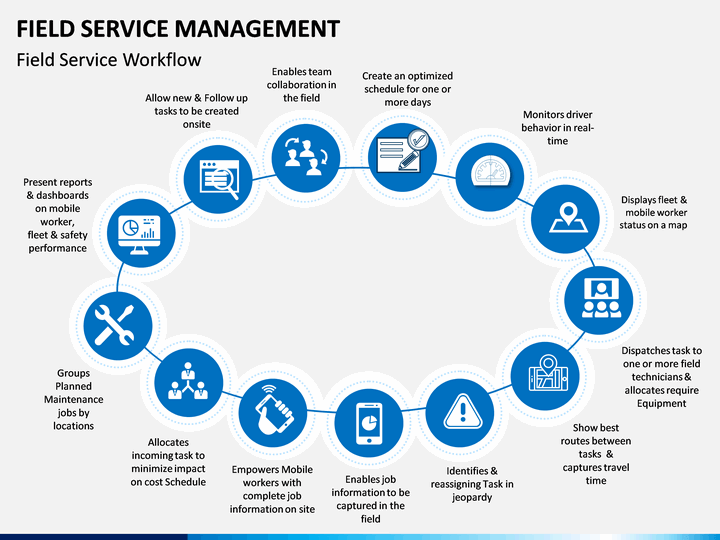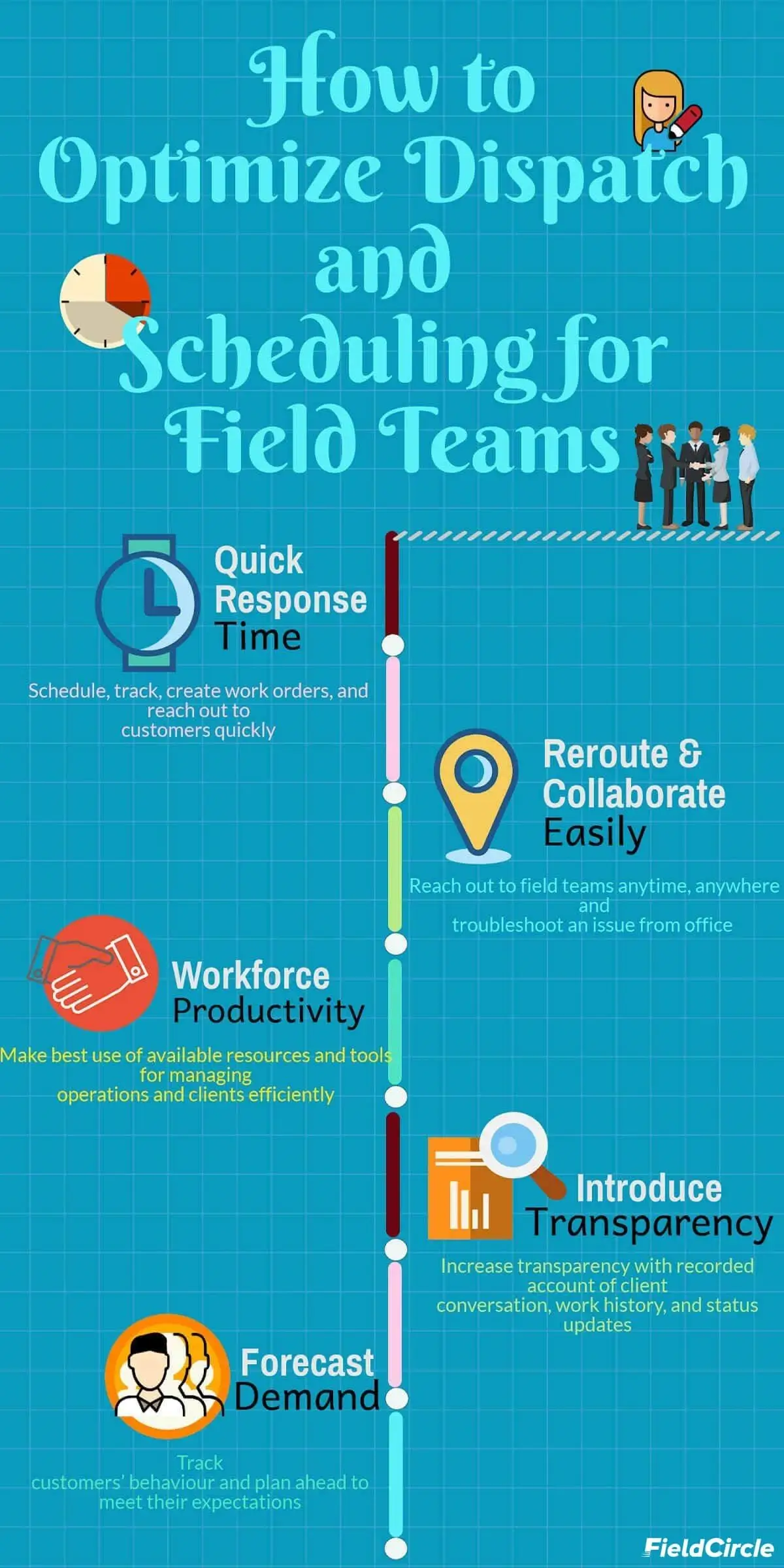Top Ways Dispatch and Scheduling Can Be Optimized for Field Service Teams

A disorganized dispatching and scheduling process can overburden your field service teams, bring down productivity and eat into your profits.
Imaging scheduling 50 technicians to 400 work orders in a day!
What a chaos for scheduling team and challenge for field service business this is. While sophisticated spreadsheet reduce the overwhelm, managing this kind of work daily can be quite daunting!
In the absence of an optimal dispatch and scheduling process or a field service job scheduling software, you incur unnecessarily high labour costs and tool rentals, and pay more fuel and driving charges. So, while it may seem an easy mathematics to figure out the cost of scheduling jobs and dispatching technicians, with poor processes the cost can slowly eat away at your bottom line.
Field service businesses thus have no choice but to schedule and dispatch field teams in the most optimal way. But how can field service businesses optimize their scheduling and disparch?
From the horses mouth i.e. service leaders, following is list of top 10 ways you can use to optimize your scheduling and dispatch operations and improve the bottom line-
1. Schedule on the fly
Unexpected events can arise at any time and at times businesses might struggle to fulfill customer requests, causing delays and frustration for both the customer and the field service business.
One way to overcome the problem is scheduling and dispatching in real-time. Using a field service application, field managers can identify technicians with the required skills and quickly assign them tasks, so that technicians can address urgent customer requests, in minimal response time. By consistently minimizing any potential downtime even for emergency requests, you thus enhance your reputation.
2. Automate wherever required
Manual assignment of tasks for each appointment can take a lot of time, especially in scenarios where multiple appointments need to be scheduled simultaneously. The process can be overwhelming for dispatchers, who have to juggle multiple factors such as technician availability, skillset, location, and urgency of the request, among others. This can result in missed appointments, longer wait times, and decreased customer satisfaction.
To beat this, scheduling automation can expedite decision-making and help build perfect dispatch schedules, where there are fewer return visits and a better experience is offered to your customers.
3. Chart Efficient Routes
Routing field workers from one job to the next is a complex task for dispatchers, who have to consider a multitude of variables that can change rapidly. Unforeseen circumstances like traffic delays, road closures, and bad weather can result in unexpected delays Using a field service routing software is a proven way to route with perfection. By exploring capabilities of field service application, services managers can swiftly and seamlessly identify optimal routes based on all relevant factors.
Furthermore, field teams can access these routes on their mobile devices.When field teams have constant access to the most efficient route for each assignment, they can spend less time on the road and more time delivering exceptional service to more customers.
4. Be the First One to Answer a Call
Speaking of customers’ modern-day expectations, 24/7 availability has become an industry staple. Due to the limitless connectivity that makes everything accessible with a single click, a service provider that aims towards competitiveness and relevance must be the first one to help the customer in need.
This calls for fast response time optimization.
Being the first to answer a call is pretty much impossible without field service scheduling software tech. Designed specifically for field service providers, these solutions allow you to assign and dispatch agents based on where they are when they will be available, and how specialized they are for a task.
5. Collaborate with Ease
The best way to collaborate seamlessly is using technology to your advantage – you can leverage a cutting-edge communication tools either built into your field service software or standalone app. By streamlining communication, you may expect a big turnaround in your team’s efficiency and work quality.
Equipped with a cloud-based solution, field service agents can easily reach out to the in-house team for assistance or get in touch with a fellow agent who can troubleshoot an issue from the office. The entire service history is also available, along with guidebooks which can be accessed right on the spot.
6. Get In-Hand Notifications
Waiting for a technician to arrive can be a frustrating experience for customers, particularly if they are unsure when to expect the technician or if there will be any unexpected delays. Customers want to feel valued and respected, and when they are left in the dark about the status of their service appointment, it can undermine their trust in the service provider.
With automatic notifications to customers, inform them when a technician is en route, giving them a sense of control over their schedule and allowing them to plan accordingly. Additionally, if the technician is running late or there are unexpected delays, it can provide updates to customers in real time, keeping them informed and helping them make any necessary adjustments to their plans.

Image Source :- sketchbubble
7. Empower Employees To Make Choices
Field service jobs often land up technicians in a situation where contextual decision-making is inevitable. Connecting with field managers even for a petty issue can delay the process of delivering solution. As a result, field technicians must be offered the flexibility to take decisions in favour of the servicing and repair operations.
Individual decision-making reduces time consumed by to-and-fro communication between field technicians and field managers. As field managers are constantly interacting with multiple field technicians working on different problems, they may not be able to quickly connect with technicians. So, if technicians have to wait for their manager’s approval, the service process consumes higher time. With the right protocols set for allowing technicians to make decisions, field service businesses can significantly optimize the service time.
8. Analyze The Past Plan Data
Field managers often face the problem of getting the complete historical service data to analyze the trends and patterns. Because it helps organizations to make informed decisions about scheduling and resource allocation, improving efficiency and productivity.
For instance, field service scheduling software can analyze historical data to identify the most common types of service requests and the time it takes to complete them. This analysis can help dispatchers assign technicians with the required skill set to each job, reducing the need for callbacks and improving customer satisfaction.
9. Track in real time using Live Maps
Managing a busy day with limited visibility into the whereabouts and progress of their field technicians can be difficult. This can lead to missed appointments, delays in service delivery.
Equipped with GPS, the problem can be addressed using live maps, thereby allowing managers to get real-time visibility into the location and status of field technicians.
Live maps offer a bird’s eye view of all the team members, where they’re heading next, and even provide a historical view of a technician’s entire day. This level of insight allows dispatchers to have a complete 360-degree view of operations, which is automatically documented for reporting and analysis purposes.
In essence, live maps with GPS technology offer a comprehensive solution to improve the efficiency and effectiveness of field teams.
10. Introduce Transparency to the Field
Speaking of productive team members, field service operations don’t have to completely rely on managers. When agents themselves are empowered with an overview of your company’s workflow, they can take the initiative and employ a proactive approach to providing fast and dependable service. This not only will help you improve your service technician performance but will also help in improving the most used and tracked field service KPIs.
Improve Efficiency and Revenue with Smart Dispatching and Scheduling
The efficiency of scheduling and dispatch management has a significant impact on the morale and performance of your field team, ultimately affecting the bottom line of your organization. Therefore, it is crucial to address the challenges associated with these processes to ensure high productivity and operational efficiency in your field service teams.

To establish or sustain a profitable, efficient, and productive field service operation, they must discard outdated manual methods and empower dispatchers and field service teams. Achieving this goal demands a solution that enhances workforce visibility, automates scheduling, and assigns the appropriate worker to each job.
Building a high performance field service team is easy but when you have right tools like FieldCircle, that can help you manage scheduling and dispatch processes effectively by managing complex scheduling process, optimize routes, ensure proper resource allocation, streamline communication, and more.
Questions? Feel free to reach out to one of our experts or schedule a demo today to learn how we can help.

